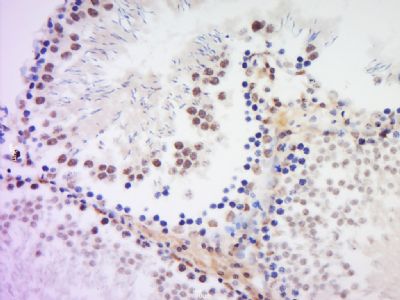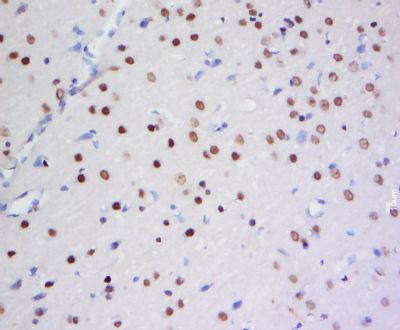HSH2D Polyclonal Antibody
Purified Rabbit Polyclonal Antibody (Pab)
- SPECIFICATION
- CITATIONS
- PROTOCOLS
- BACKGROUND

Application
| WB, IHC-P, IHC-F, IF, ICC, E |
|---|---|
| Primary Accession | Q96JZ2 |
| Reactivity | Rat, Dog, Bovine |
| Host | Rabbit |
| Clonality | Polyclonal |
| Calculated MW | 39 KDa |
| Physical State | Liquid |
| Immunogen | KLH conjugated synthetic peptide derived from human HSH2D |
| Epitope Specificity | 21-120/352 |
| Isotype | IgG |
| Purity | affinity purified by Protein A |
| Buffer | 0.01M TBS (pH7.4) with 1% BSA, 0.02% Proclin300 and 50% Glycerol. |
| SUBCELLULAR LOCATION | Cytoplasm. Nucleus. |
| SIMILARITY | Contains 1 SH2 domain. |
| Post-translational modifications | May be phosphorylated by FES and ACK1. |
| Important Note | This product as supplied is intended for research use only, not for use in human, therapeutic or diagnostic applications. |
| Background Descriptions | HSH2 is a 352 amino acid nuclear and cytoplasmic protein that is predominantly expressed in spleen and hematopoietic cells, such as peripheral blood leukocytes, and weakly expressed in prostate, thymus, heart, small intestine and placenta. Containing an SH2 domain, four PXXP polyproline sequences and two possible tyrosine phosphorylation sites, HSH2 interacts with tyrosine kinases Fes and ACK. Considered an adaptor protein, HSH2 participates in tyrosine kinase signaling and may be involved in the regulation of cytokine signaling and cytoskeletal reorganization in hematopoietic cells. HSH2 may also act to attenuate apoptosis through modulating the apoptotic response by promoting mitochondrial stability. HSH2 exists as two alternatively spliced isoforms and is encoded by a gene located on human chromosome 19p13.11. |
| Gene ID | 84941 |
|---|---|
| Other Names | Hematopoietic SH2 domain-containing protein, Hematopoietic SH2 protein, Adaptor in lymphocytes of unknown function X, HSH2D, ALX |
| Target/Specificity | Predominantly expressed in spleen and hematopoietic cells such as peripheral blood leukocytes and weakly expressed in prostate, thymus, heart, small intestine and placenta. |
| Dilution | WB=1:500-2000,IHC-P=1:100-500,IHC-F=1:100-500,ICC=1:100-500,IF=1:100-500,ELISA=1:5000-10000 |
| Storage | Store at -20 ℃ for one year. Avoid repeated freeze/thaw cycles. When reconstituted in sterile pH 7.4 0.01M PBS or diluent of antibody the antibody is stable for at least two weeks at 2-4 ℃. |
| Name | HSH2D |
|---|---|
| Synonyms | ALX |
| Function | May be a modulator of the apoptotic response through its ability to affect mitochondrial stability (By similarity). Adapter protein involved in tyrosine kinase and CD28 signaling. Seems to affect CD28-mediated activation of the RE/AP element of the interleukin-2 promoter. |
| Cellular Location | Cytoplasm. Nucleus. |
| Tissue Location | Predominantly expressed in spleen and hematopoietic cells such as peripheral blood leukocytes and weakly expressed in prostate, thymus, heart, small intestine and placenta |

Thousands of laboratories across the world have published research that depended on the performance of antibodies from Abcepta to advance their research. Check out links to articles that cite our products in major peer-reviewed journals, organized by research category.
info@abcepta.com, and receive a free "I Love Antibodies" mug.
Provided below are standard protocols that you may find useful for product applications.
If you have used an Abcepta product and would like to share how it has performed, please click on the "Submit Review" button and provide the requested information. Our staff will examine and post your review and contact you if needed.
If you have any additional inquiries please email technical services at tech@abcepta.com.













 Foundational characteristics of cancer include proliferation, angiogenesis, migration, evasion of apoptosis, and cellular immortality. Find key markers for these cellular processes and antibodies to detect them.
Foundational characteristics of cancer include proliferation, angiogenesis, migration, evasion of apoptosis, and cellular immortality. Find key markers for these cellular processes and antibodies to detect them. The SUMOplot™ Analysis Program predicts and scores sumoylation sites in your protein. SUMOylation is a post-translational modification involved in various cellular processes, such as nuclear-cytosolic transport, transcriptional regulation, apoptosis, protein stability, response to stress, and progression through the cell cycle.
The SUMOplot™ Analysis Program predicts and scores sumoylation sites in your protein. SUMOylation is a post-translational modification involved in various cellular processes, such as nuclear-cytosolic transport, transcriptional regulation, apoptosis, protein stability, response to stress, and progression through the cell cycle. The Autophagy Receptor Motif Plotter predicts and scores autophagy receptor binding sites in your protein. Identifying proteins connected to this pathway is critical to understanding the role of autophagy in physiological as well as pathological processes such as development, differentiation, neurodegenerative diseases, stress, infection, and cancer.
The Autophagy Receptor Motif Plotter predicts and scores autophagy receptor binding sites in your protein. Identifying proteins connected to this pathway is critical to understanding the role of autophagy in physiological as well as pathological processes such as development, differentiation, neurodegenerative diseases, stress, infection, and cancer.



